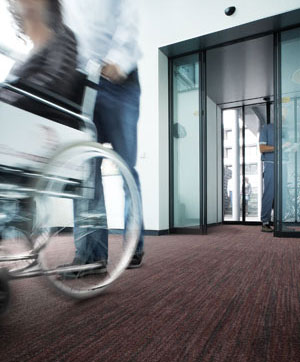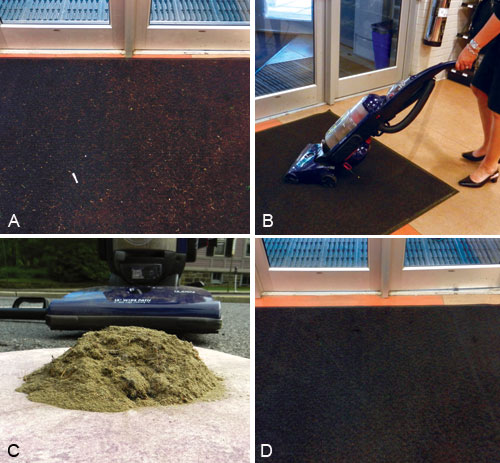The Significance of Entry Flooring Systems
Applicable Codes and Standards
The collection of codes published by the International Code Council (ICC) includes the Building Code and Fire Code which address in detail the requirements for safety and slip resistance in means of egress which often may include a building entrance as well. This is also often true for jurisdictions that have adopted their own localized or state codes. Essentially, any area that is part of an exit that does not have slip resistance accounted for in the floor is not only out of compliance with the codes, it can be dangerous or fatal in emergency situations. The entrance flooring system can clearly contribute to helping achieve a code-compliant and safe condition then. While this is the appropriate starting point, there are also a number of other applicable standards that come into play and need to be addressed whenever specifying and designing entrance flooring systems:
 |
Entrance flooring systems can be specified to meet handicapped accessibility requirements. Photo courtesy of Forbo Flooring Systems |
Handicapped Accessibility
The Americans with Disabilities Act (ADA) sets out specific requirements for barrier-free environments including unobstructed paths of travel. Much of this has been codified in American National Standard ICC A117.1 (the Standard) which is appended to most building codes as the prescriptive requirements to achieve such barrier-free environments. Chapter 3 of this standard specifically addresses floor surfaces which includes entrance flooring systems. Section 302 indicates that flooring must first be stable, firm and slip resistant. For carpeted systems, it requires that edges are secured, that the height is limited and addresses the texture, all of which are achievable in entrance flooring systems. In cases where there are openings, such as in rigid grid mat systems, openings in the surface must not allow passage of a 1/2-inch diameter sphere. Where these openings are elongated as is typical in entrance flooring mats then they must be perpendicular to the direction of travel which is the common and recommended manner of installing them.
Changes in level are addressed in Section 303 of the Standard. This would apply to the edges of entrance flooring systems over which people are walking or riding a wheelchair. The maximum allowed vertical rise is 1/4 inch which can be increased to 1/2 inch if the edges are beveled with a slope of no more than 1:2 on the bevel. Most entrance flooring systems can readily accommodate these requirements, although some do require a recessed floor slab in order to remain level and flush with the surrounding path of travel or within the 1/4-inch to 1/2-inch limitations.
| Textile-Based Mats At Princeton University Store, Princeton, New Jersey | ||
The Princeton University Store in Princeton, New Jersey, is exposed to high volumes of student and visitor foot traffic on a daily basis. John Augustine, the University Store manager, needed a solution to stop large amounts of dirt and moisture from being walked into the store each day. A textile-based entry flooring mat system was selected as a solution. Six months after installation, the manufacturer sent a representative to visit the University Store to inspect the flooring, which was now dirty from heavy use. A quick cleaning with a residential-grade vacuum cleaner revealed the impact of using this textile-based system at the store entrance—literally piles of dirt and debris were removed. The textile entrance flooring not only prevented the dirt from being walked into the store, it also reduced the facility’s cleaning and maintenance costs directly. Further, they have lowered the risk of slip and fall incidents. After six months of heavy daily use, the textile flooring performed extremely well on all four R’s. The condition of the mat before cleaning (see photo A) showed that it effectively removed dirt from shoes and retained it in the mat. The use of a common vacuum cleaner (see photo B) and the resulting piles of dirt that were collected (see photo C) attested to the ability of the flooring to first retain a considerable quantity of dirt and then release it when cleaned. When complete, the cleaned textile-based mat was able to recover quite well, was ready for continued use and still looked great (see photo D). Altogether, the University Store and the manufacturer were very pleased with the performance and the results of this installation. There are of course other accessibility requirements for paths of travel including doorways, obstructions, etc. and those will need to be coordinated in the overall design. There is nothing about the entrance flooring system, however, that should impair or impede that coordinated design effort.
|
Occupational Safety and Health Administration (OSHA)
Consistent with this federal agency's mission of protecting workers, they have identified requirements for walking surfaces and means of egress. Entrance systems that fall within these areas can be shown to be compliant with OSHA regulations as long as they are properly installed and maintained.
ASTM F1637 Standard Practice for Safe Walking Surfaces
The American Society of Testing Materials produces many standard specifications for numerous things related to design and construction. In the case of walking surfaces, ASTM F1637 is the published standard available. It addresses indoor and outdoor walking surfaces indicating that walkway surfaces shall be stable, planar, flush and even to the extent possible. It goes on to say that walking surfaces shall be slip resistant under expected environmental conditions and use. It also states that when wet conditions are reasonably foreseeable, then an abrasive additive, grooving, texturing or other appropriate means shall be incorporated to render the surface slip resistant. This is where entrance flooring systems can readily address these concerns and allow for the removal and retention of water that is removed when the system is cleaned. Similar to the handicapped accessibility standards, this ASTM standard calls for changes in level along the edges that are either 1/4-inch maximum when vertical or 1/2-inch maximum where they are beveled at a slope not to exceed 1:2.
Carpet systems are addressed in this standard as well with predictable requirements for it to be firmly secured and seams maintained all in the interest of avoiding pedestrian hazards. More significantly, this standard states: “Building entrances shall be provided with mats or runners, or other means to help remove foreign particles and other contaminants from the bottom of pedestrian footwear. Mats should be provided to minimize foreign particles that may become dangerous to pedestrians particularly on hard smooth floors, from being tracked on floors.” This language is exactly consistent with the design intent and purpose of entrance flooring systems. It goes on to address water by saying “Mats at building entrances also may be used to control the spread of precipitation onto floor surfaces, reducing the likelihood of the floors becoming slippery.” There is clearly recognition that the use of entrance flooring system mats will contribute to a safer walking condition when the surface becomes wet. Finally, this standard indicates the importance of good design principles. “Mats shall be of sufficient design, area and placement to control tracking of contaminants into buildings. Safe practice requires that mats be installed and maintained to avoid tracking water off the last mat onto floor surfaces. Mats, runners and area rugs shall be provided with safe transition from adjacent surfaces and shall be fixed in place or provided with slip-resistant backing.” The ability for entrance flooring systems to be secured in place during construction makes them a superior choice over removable entrance mats or runners.
Clearly, then, there are numerous sources of requirements and safety standards that can be consulted on for entrance flooring systems. It is important that the architect as designer and specifier understands and addresses these standards as part of the entrance design. However it is common for manufacturers of entrance flooring systems to be keenly familiar with all of them and design their products accordingly.










